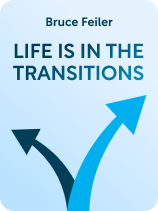

This article is an excerpt from the Shortform book guide to "Life Is in the Transitions" by Bruce Feiler. Shortform has the world's best summaries and analyses of books you should be reading.
Like this article? Sign up for a free trial here.
How can you cope when life throws unexpected changes your way? What are the different types of life changes? Why should you let go of your dream of living a “linear life”?
For his book Life Is in the Transitions, Bruce Feiler traveled around the US, interviewing hundreds of people about the ups and downs of their life stories. He argues that although popular wisdom tells you to expect one major midlife crisis, most people actually face dozens of life-changing events.
Here’s an overview of Feiler’s book, along with tips for overcoming what life throws at you.
Overview of Life Is in the Transitions
You’ve likely heard of the idea of a midlife crisis—a phase someone hits in middle age where they reevaluate their choices and confront their mortality. But Bruce Feiler argues in Life Is in the Transitions that this narrative is false: Instead of going through one major transition at a predetermined time, we go through many transitions in life. These upheavals tend to follow a particular pattern; by understanding that pattern, says Feiler, we can better weather the storms that come our way.
Feiler is the author of several books, including The Search, The Council of Dads, The Secrets of Happy Families, and Walking the Bible. He also writes The Nonlinear Life blog for Psychology Today (based on the research that inspired Life Is in the Transitions) and previously wrote the monthly This Life column for The New York Times. For this book, Feiler traveled around the United States, interviewing hundreds of people about the ups and downs of their lives as part of what he calls The Life Story Project.
In this guide, we’ll start by examining the types of changes everyone will face at different points in their lives. Then, we’ll discuss why these transitions can be so challenging and outline Feiler’s advice for navigating them more smoothly. In our commentary, we’ll explore other experts’ definitions of life changes, insights from people whose lives have changed dramatically, and psychological perspectives that can help you deal with both positive and negative life events.
Change at Any Age
According to Feiler, we often think of life in stages—such as childhood, adolescence, adulthood, and old age—with predictable transitions at predetermined points along that path. For example, you might expect to graduate from college in your early 20s, establish a career in your 30s, and retire in your 60s. Feiler calls this “the linear life,” and he argues it’s a myth: In reality, life doesn’t follow a linear path, and we can face transitions at any point. This myth is dangerous because it colors our expectations; we expect to move smoothly from one phase of life to another, so when we inevitably face curveballs (or don’t hit certain milestones at the same time as our peers), we fear that something has gone wrong.
Feiler argues that instead of clinging to the myth of the linear life, we need to embrace the idea that life is nonlinear. There is no predetermined path, so we should expect life-altering changes at any time.
According to Feiler, there are two types of life-altering changes that most people experience—adjustments and transformations. Let’s explore each.
Adjustments
Feiler says the first type of change is adjustments (he calls these “disruptors”). Adjustments are events that interrupt our status quo, making life feel different after they take place. These events can be positive or negative, and they might seem large or small from the outside—either way, they fundamentally change our daily lives. According to Feiler, the average person can expect to experience 30 to 40 adjustments in their lifetime.
In his research, Feiler found 52 kinds of adjustments that he says represent the full range of life changes, which he divides into five categories:
- Relationships: This category encompasses relationship changes of all kinds, from the births and deaths of loved ones to events like sexual abuse and addiction that affect how you relate to people.
- Health: This category includes all types of physical and mental illnesses and injuries, as well as recovery journeys.
- Identity: This category covers life events that affect your self-image as well as how others perceive you—for example, immigration, changes in criminal status, sexual and gender-related awakenings, and shifts in socioeconomic class.
- Perspective: This category covers experiences that change the way you see the world, including major sociopolitical events, extended travel, education, and shifts in religious belief.
- Career: This category encompasses changes in your work life—what you do for a living, how you feel about it, how you’re treated at your job, and joblessness and retirement.
Transformations
The second type of change Feiler describes is transformations (or what he calls “lifequakes”). These are events that redefine how we think about and derive meaning from our lives. Transformations are grander and more disruptive than adjustments, so much so that we use them to mark the passage of time. For example, instead of thinking of your life in terms of decades, you might think in terms of the time before and after you got married. What makes a life change transformative is relative: Some people go through major traumas that aren’t transformative because their view of life doesn’t fundamentally change; others are thrown onto an entirely new course by a seemingly minor event.
Transformations can fall into any of the five categories of adjustments that Feiler describes. They may be events you willingly choose, like getting sober or adopting a child, or events that are out of your control, like chronic illness. According to Feiler’s research, transformations tend to be personal rather than collective—for example, a personal diagnosis is more likely to be transformative than an international pandemic.
Why do certain life changes become transformative? Feiler points to moments of vulnerability as the deciding factor. He explains that when you experience an adjustment during a difficult time, multiple adjustments in a row, or a slew of adjustments all at once, they’re more likely to shake up your life in a profound way. For example, say you’ve been looking for a new job, but your applications keep getting rejected. The final rejection letter could become transformative if the stress and frustration from repeated setbacks have accumulated, leaving you feeling vulnerable and questioning your sense of self and purpose. Your heightened vulnerability could trigger a major career pivot where you decide to change fields or go back to school.
Why Life Changes Are Hard to Navigate
Feiler explains that many people struggle to navigate life changes, especially transformations, for two reasons. Let’s explore each.
Reason 1: Transformations Change the Meaning of Your Life
Humans have an innate need to make meaning out of their life stories—the first expert to recognize this, Feiler says, was psychologist Victor Frankl, who explored how people found meaning in the wake of the Holocaust in his book Man’s Search for Meaning. Feiler proposes that meaning is composed of three elements—agency, belonging, and cause:
- Agency is a sense of personal power—the feeling that what you do matters.
- Belonging describes how you fit in with, value, and feel valued by others
- Cause is your connection to something larger than yourself that guides your actions.
According to Feiler, we need all three of these elements to feel a sense of meaning in life. However, most of us have one element that dominates our lives in a given season. When a transformation hits, it challenges our dominant source of meaning. To cope with that sudden change, we need to shift to a new dominant source of meaning. To illustrate, consider how near-death experiences often make people reevaluate their priorities: A workaholic who has a stress-related heart attack might suddenly prioritize spending time with family (belonging) over career achievements (agency), or a victim of a violent crime might shift focus from their personal life (agency) to social and political advocacy (cause).
Feiler says this shift in meaning-making takes time, as it requires reflection, exploration, and a willingness to embrace contradiction (since it may be difficult to reconcile your past experiences with your evolving understanding of what matters to you). Your new source of meaning probably won’t come to you as an epiphany, and you might experience a lot of emotional ups and downs as you navigate the transition period after a transformation.
Reason 2: Adapting to Change Isn’t Simple or Easy
Feiler says that each transformation is followed by an adaptation stage with three distinct phases:
- First, you realize that your old reality has ended, and you grapple with the difficult emotions that can accompany loss.
- Then, you start coping with (or struggling to cope with) the change by letting go of some habits and beliefs and replacing them with new ones.
- Finally, your new reality begins. You see yourself as a different person than you were before the transformative event, with a new sense of meaning, and you integrate the experience into your overall life story.
Feiler notes that these phases don’t always happen in that exact order, and you may need to revisit one or more stages. For example, if a loved one dies, you might experience several bouts of grief (the first phase). Additionally, Feiler says that most people have one phase they’re particularly good at dealing with and one they struggle with—for example, you might take a loved one’s death in stride emotionally but find it difficult to reconstruct your life without them (the second phase). Since adapting after change isn’t a linear or straightforward process, it can feel arduous. As you struggle through and revisit various phases of adjustment, you may feel uncertain about your future and doubt whether you’re making adequate progress in life.
How to Transition After a Life Change
Navigating life changes can be difficult, but Feiler argues that you can make it easier by approaching it intentionally and proactively. He proposes seven strategies that can help you adapt to life changes; let’s explore each.
Strategy 1: Cope With Your Emotions
Feiler’s first strategy involves understanding and finding ways to cope with the emotions that come up while you’re grieving the end of your old reality—particularly fear, sadness, and shame.
How to Cope With Fear
During his research, Feiler observed that many people had to overcome fear as they transitioned from a major life change. He names a few common strategies that can help with this. The first is to compare the discomfort you feel in your current reality to the fear of making a big life change. Transitions can be scary, but staying stuck in the same old rut forever may be even more terrifying.
Another strategy Feiler recommends is to make a list of your goals, which can motivate you to overcome your fears.
Finally, Feiler says you can choose to face your fears head on—for example, if you’re afraid of going back to school, you might decide to swallow that fear and sign up for classes anyway.
How to Cope With Sadness
Another common emotion people face during life changes is sadness. Feiler notes three strategies people use to cope with sadness. The first is accepting the sadness—allowing it to be part of your story without trying to get rid of it. The second is leaning on loved ones for support while you grieve. The third is facing the source of your sadness by talking about it or deliberately reminding yourself of it, allowing you to fully feel your grief.
How to Cope With Shame
Finally, many people feel shame during transitions as they look back on the perceived failures of their lives. In interviews, Feiler gathered that the best way to combat this shame is to invest time and effort into the aspects of your life that the shame impacts the most. You can do this by taking actions that directly address the areas where you feel you’ve fallen short. For example, if you feel shame about hurting your family and thus feel separated from them, the best way to counteract that shame would be to attend a family event and reconnect with them—to restore your sense of belonging.
Strategy 2: Mourn Deliberately
Feiler’s second strategy for navigating transitions is to mourn deliberately. One way to do this is to create personally significant rituals to mark the ending of one life phase and the beginning of another. These rituals allow you to externalize and honor your grief, whether you’re mourning a literal death or a symbolic one. Processing loss in this way is especially important in the case of traumatic loss—if you don’t process the loss properly, you’re more likely to develop symptoms of trauma later on.
According to Feiler, there are four types of mourning rituals to choose from:
- Individual rituals, where you create or do something personally meaningful to honor what you’ve lost (and what you’ve gained by losing it). For example, one of Feiler’s interviewees ate his first cheeseburger after leaving a religion that forbade it.
- Community rituals, where you process the loss with the help of your community. For example, some people throw divorce parties to celebrate their ending marriages.
- Identity rituals, where you change your name to distance your new and former selves.
- Renewal rituals, where you make changes to your body, habits, or surroundings with the intention of making space for a new chapter of your life to begin. For example, you might overhaul your wardrobe after leaving an industry with a strict dress code.
Another way to mourn deliberately, according to Feiler, is to gather and periodically interact with physical keepsakes that remind you of the thing you’re grieving. Feiler says that such objects encapsulate memories, and interacting with them allows us to revisit those memories whenever we need to. For example, if a friend of yours who was an artist has died, hanging a piece of art on their wall could create opportunities to feel their presence again and remember the moments you shared together.
Strategy 3: Explore New Ways of Being
Feiler explains that one of the most difficult parts of navigating change is deciding your next steps. In the wake of a transformation, your old habits and beliefs no longer fit—so you need to let them die. In some cases, you might welcome this—for example, if you have a health crisis that forces you to stop smoking, you could feel eager to make the change and grateful for the wakeup call. In other cases, letting go of some aspects of your former self can be hard. For example, if you took a pay cut upon accepting a new job, you might struggle to adjust your spending habits. Regardless, Feiler says it’s important to let go of the habits and beliefs that no longer serve you—then, you can replace them with new ones that align with your current reality.
You need to find new ways to fill your days and discover what feels meaningful to you now, but developing new habits and beliefs isn’t always easy. The approach you start with just after a life change may not be the one you stick with, and Feiler says that’s OK. What’s important is that you give yourself opportunities to experiment with potential paths forward.
Feiler explains that you can approach the challenge of figuring out your next steps in one of three ways—by embracing structure, embracing chaos, or seeking wisdom.
Strategy 4: Tap Into Creativity
In Feiler’s research, he found that many people turned to creative outlets during transitional periods of their lives. He explains that creating something can be cathartic, and it’s also a good way to explore the new feelings and ideas that result from transformational experiences.
Here are four ways you can tap into creativity:
Pick up an art or craft you’ve never tried before. Transitions can leave you feeling isolated, bored, or confused. Feiler says these emotions make excellent creative fodder, since they make space for innovative ideas and out-of-character interests to pop up. This makes transitions an excellent opportunity to stretch your creative limits.
Resume an art or craft you forgot you loved. Many people exhibit artistic talents as children or young adults, but they put them aside as life becomes busier and priorities shift. According to Feiler, transitions are a good opportunity to reconnect with the artistic side of yourself.
Find new ways to move your body. Feiler argues that physical movement can unlock ideas and aspects of your personality that have been lying dormant. For example, starting a yoga practice could teach you to connect with your emotions and could promote a sense of inner calm.
Take up writing. Writing helps you organize your thoughts and make sense of your experiences. Feiler says this is especially helpful when you’re experiencing turbulence after a transformative life change.
Strategy 5: Talk About It
Feiler explains that sharing your transformation with others can make enduring the transformation easier. Talking about your experiences cuts through loneliness—which many people experience when their lives are in a state of upheaval—and has even been shown to improve physical health outcomes.
Feiler describes five ways that talking about what you’re going through with others can help you:
You might receive support. Feiler explains that when you share about your life, you give others a chance to understand, comfort, and validate you, which can make the burden you’re carrying feel easier to bear.
You might feel encouraged. According to Feiler, letting others know what you’re dealing with opens the door to advice and points of view that can keep you moving forward. For example, talking with friends about your career options could help you clarify your goals and create an action plan.
You might get a reality check. During a transition, you may be prone to unrealistic or unhelpful thought patterns. Feiler says sharing your thoughts with others allows you to hear outside perspectives that help you see things more clearly.
You might be inspired. If you open up about what you’re going through, you could learn that someone else has been through something similar and emerged stronger. According to Feiler, hearing their stories can offer you hope and can motivate you to persevere.
You might get negative feedback. Feiler acknowledges that not everyone you’re vulnerable with will be sympathetic to your struggles, hopes, and fears. However, if someone reacts poorly to your story, you can still grow from that experience: The desire to prove them wrong or address their criticism can motivate you to work harder, find meaning in your transformation, and create a life worth living.
Strategy 6: Take a Step Into Your New Life
As we’ve discussed, transformations tend to overhaul your entire life, turning you into a different person than you were before. One sign that you’re ready to embrace your new identity is that you start doing mundane tasks that were too difficult to tackle during the most tumultuous parts of your transition. For example, if you broke both your legs, taking a shower standing up would signal that you’re beginning to adapt to your new reality and that you’re ready to reclaim a sense of normalcy and agency in your daily life. Feiler says that these small moments are cause for celebration. They can also give you the confidence you need to start making bigger moves, like tackling a new project or goal (for example, running a 5K race once your legs have healed).
Strategy 7: Rewrite Your Life Story
Recall that transformations are hard to navigate because they challenge your sense of meaning. Feiler says that eventually, you’ll integrate your transformative experience into your life story and discover how to make meaning out of the experience. He lists two signs that you’re reaching this point:
You shift the story of your transformation from present to past tense. This suggests that you’ve gained enough psychological distance from the experience to process it and figure out what it means to you.
You choose to frame your story positively. You may not feel very positive about what happened to you yet, but you assign the meaning you want your story to have. You also emphasize the good things that came from the difficult event, rather than the bad things. This suggests that you’re open to finding personal growth and purpose within the experience, even if it’s still challenging or painful in some ways.
Exercise: Embrace a Change in Your Life
Feiler suggests that life is full of unpredictable changes that can happen at any age. Reflect on one of the changes you’ve experienced to better understand how it has shaped your life and sense of meaning.
- Think back to a recent change in your life. Was it an adjustment or a transformation? Describe the change and why you classify it as one or the other.
- Reflect on how this change impacted your sense of identity or your perspective on life. What did you learn about yourself through this experience?
- Consider Feiler’s idea that life changes can challenge our sources of meaning—agency, belonging, and cause. During the life change you described, did your source of meaning change? If so, how?
- When you experienced that life change, did you use any of the strategies Feiler suggests to make it easier? For example, maybe you turned to a creative outlet to cope.
- Which of Feiler’s strategies would you like to use the next time your life changes? How do you think this would help you?

———End of Preview———
Like what you just read? Read the rest of the world's best book summary and analysis of Bruce Feiler's "Life Is in the Transitions" at Shortform.
Here's what you'll find in our full Life Is in the Transitions summary:
- How to deal with curveballs and obstacles in life
- The pattern that most of life’s disruptions follow
- How to rewrite your life story in a positive way






